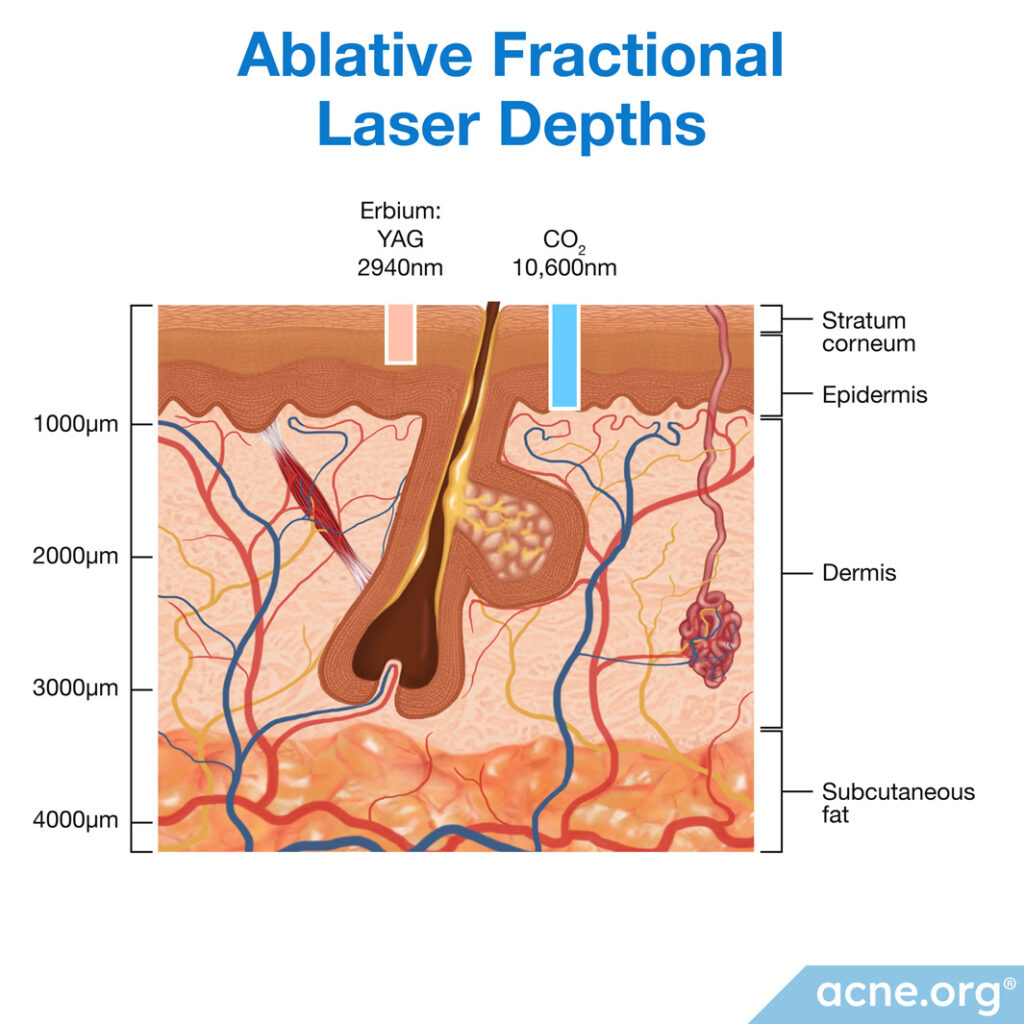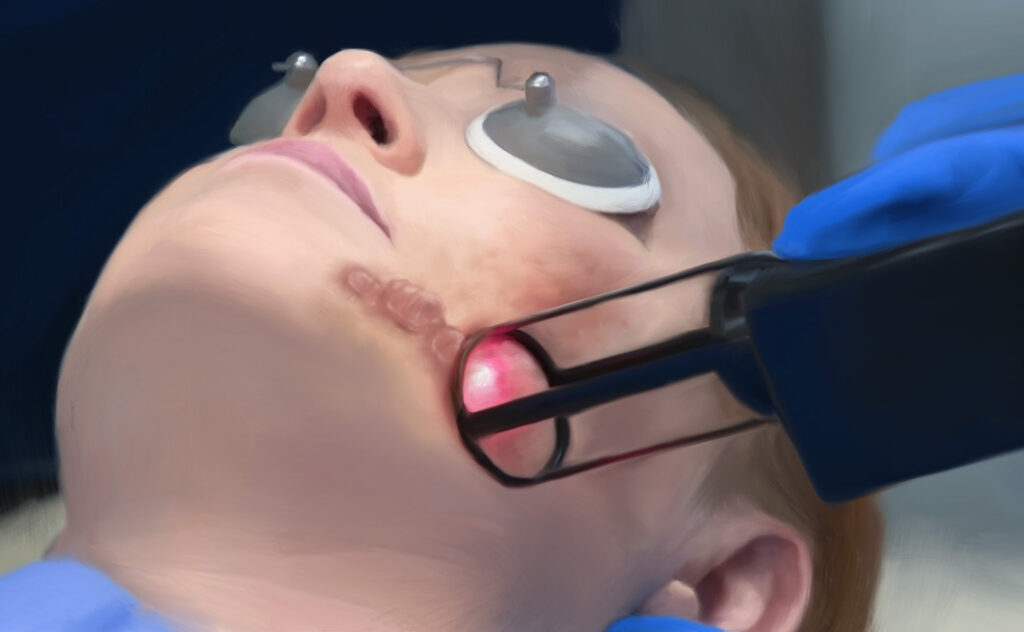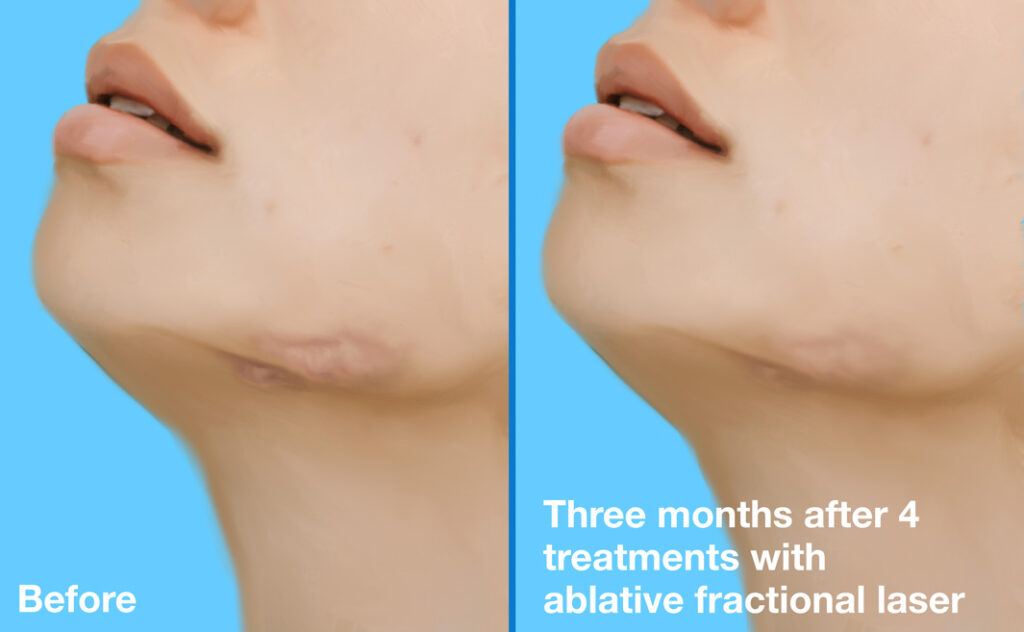Ablative fractional lasers shine an intense beam of light onto a raised scar in a grid-like pattern so that areas of skin in between the pinpoints are left untouched. This ablation removes layers of the scar tissue, which helps flatten and smooth the raised scar.
The heat generated by the laser not only removes the scarred tissue but also stimulates the underlying skin cells to produce new collagen, a key structural protein in the skin. The new collagen fibers reorganize in a more orderly and natural pattern compared to the disorganized collagen in scar tissue.
As the skin heals from the micro-injuries, it undergoes a process of tightening and regeneration. This helps in reducing the raised appearance of the scar, improving skin texture, and blending the treated area with the surrounding skin.
Ablative (skin-removing) lasers: “Ablative” means “removing,” in this case, removing the skin. Ablative lasers work by quickly heating up water molecules in the epidermis (the upper layer of the skin), which essentially “vaporizes” this skin layer. This is in contrast to non-ablative lasers, which do not vaporize the skin. Because ablative lasers completely remove the epidermis and trigger it to regrow, they can achieve good results, but they also come with a long recovery time and a relatively high risk of side effects.
Fractional lasers, also known as fractionated lasers: These newer lasers deliver many small pinpoints of laser light in a grid-like pattern so that areas of skin in between the pinpoints are left untouched. Because only a small portion of the skin is damaged, healing time is shorter than with non-fractional lasers which strip the entire epidermis.1,2
Summary of ablative fractional lasers for raised scars:
- How they work: Completely removes (ablates) the epidermis of a raised scar in a dot-matrix pattern, leaving some of the skin intact
- # of treatments: 4-10 treatments at intervals of 2 to 8 weeks1-6
- Advantages: Better results compared to non-ablative lasers, and shorter recovery time compared to non-fractional ablative lasers2
- Disadvantages: Scar regrowth (relatively rare when the procedure is performed correctly), high risk of side effects, expensive, requires multiple sessions2
There are 2 main subtypes of ablative fractional lasers, each named after the material used inside the laser device, and your doctor can discuss with you about which is better for your particular raised scar(s). Lasers can be created using glass, crystals, or gasses, and the specific material determines the color of the laser light.2
The materials in lasers used for ablative fractional skin resurfacing include:
- Er:YAG (erbium-doped yttrium-aluminum-garnet) laser
- CO2 (carbon dioxide) laser
Each laser subtype penetrates the skin to a different depth. In general, ablative lasers do not penetrate deep into the dermis.
- Er:YAG (erbium-doped yttrium-aluminum-garnet) fractional laser: Does not go as deep into the epidermis as the CO2 (carbon dioxide) laser
- CO2 (carbon dioxide) fractional laser: Goes deeper into the epidermis than the Er:YAG (erbium-doped yttrium-aluminum-garnet) laser

As with all scar revision treatments, ablative fractional lasers are sometimes combined with other scar revision procedures to attain desired results.
Ablative fractional laser treatment cannot be performed when there is an active skin infection or a skin condition such as a bacterial infection, eczema, or psoriasis. Ensure your skin is clear before seeking laser resurfacing.1
Doctors do not recommend undergoing laser scar treatment for 6 months after taking oral isotretinoin (Accutane®), because during this time, the skin may respond unpredictably to laser treatment.1
Before agreeing to undergo ablative fractional laser treatment, discuss your treatment options, expected outcomes, and treatment prices with multiple doctors.
Procedure details:

Before booking your treatment, your doctor should first schedule a session to discuss the procedure, expected results, and possible complications with you and to answer your questions.
If you are planning to undergo treatment with an ablative fractional laser, your doctor may prescribe antiviral medications for you to take before the procedure in order to prevent a viral skin infection from developing after treatment.3
Ablative fractional laser treatment is usually performed in an outpatient setting.
During the treatment, the doctor will give you protective eyewear to prevent the laser from damaging your eyes.
No matter which type of laser your doctor uses, she will have to fine-tune the laser settings in order to get the best results while minimizing recovery time and side effects. Once the settings are dialed in, she will make several passes over your scar with the laser, which produces mild pain.
Anesthesia:
Ablative fractional laser treatment can be uncomfortable and anesthesia is optional. Your doctor may choose to numb the skin with:
- Topical anesthesia: A dressing containing a numbing cream is applied to the skin 30 to 60 minutes prior to the procedure6
Before-and-after:

Before and 3 months after receiving 4 treatment sessions with Er:YAG fractional laser.
References
- Omi T, Numano K. The Role of the CO2 Laser and Fractional CO2 Laser in Dermatology. Laser Ther. 23(1), 49-60 (2014).
- Buhalog B, Moustafa F, Arkin L, Lee K, Siwy K, Donelan M, Hultman CS, Shumaker PR. Ablative fractional laser treatment of hypertrophic burn and traumatic scars: a systematic review of the literature. Arch Dermatol Res. 313(5), 301-17 (2021).
- Choi JE, Oh GN, Kim JY, Seo SH, Ahn HH, Kye YC. Ablative fractional laser treatment for hypertrophic scars: comparison between Er:YAG and CO2 fractional lasers. J Dermatolog Treat. 25(4), 299-03 (2014).
- Tan J, Zhou J, Huang L, Fu Q, Ao M, Yuan L, Luo G. Hypertrophic Scar Improvement by Early Intervention With Ablative Fractional Carbon Dioxide Laser Treatment. Lasers Surg Med. 53(4), 450-7 (2021).
- Oosterhoff TCH, Beekman VK, van der List JP, Niessen FB. Laser treatment of specific scar characteristics in hypertrophic scars and keloid: A systematic review. J Plast Reconstr Aesthet Surg. 74(1), 48-64 (2021).
- Choi KJ, Williams EA, Pham CH, Collier ZJ, Dang J, Yenikomshian HA, Gillenwater TJ. Fractional CO2 laser treatment for burn scar improvement: A systematic review and meta-analysis. Burns. 47(2), 259-69 (2021).
 Acne.org Products
Acne.org Products